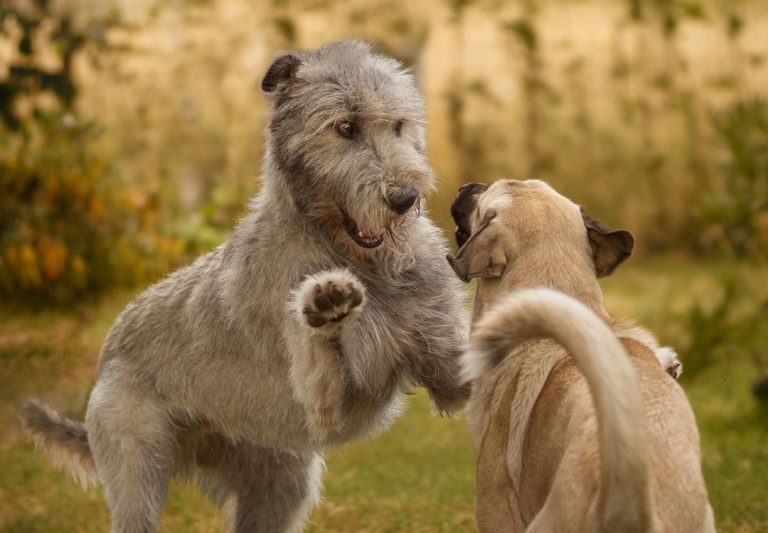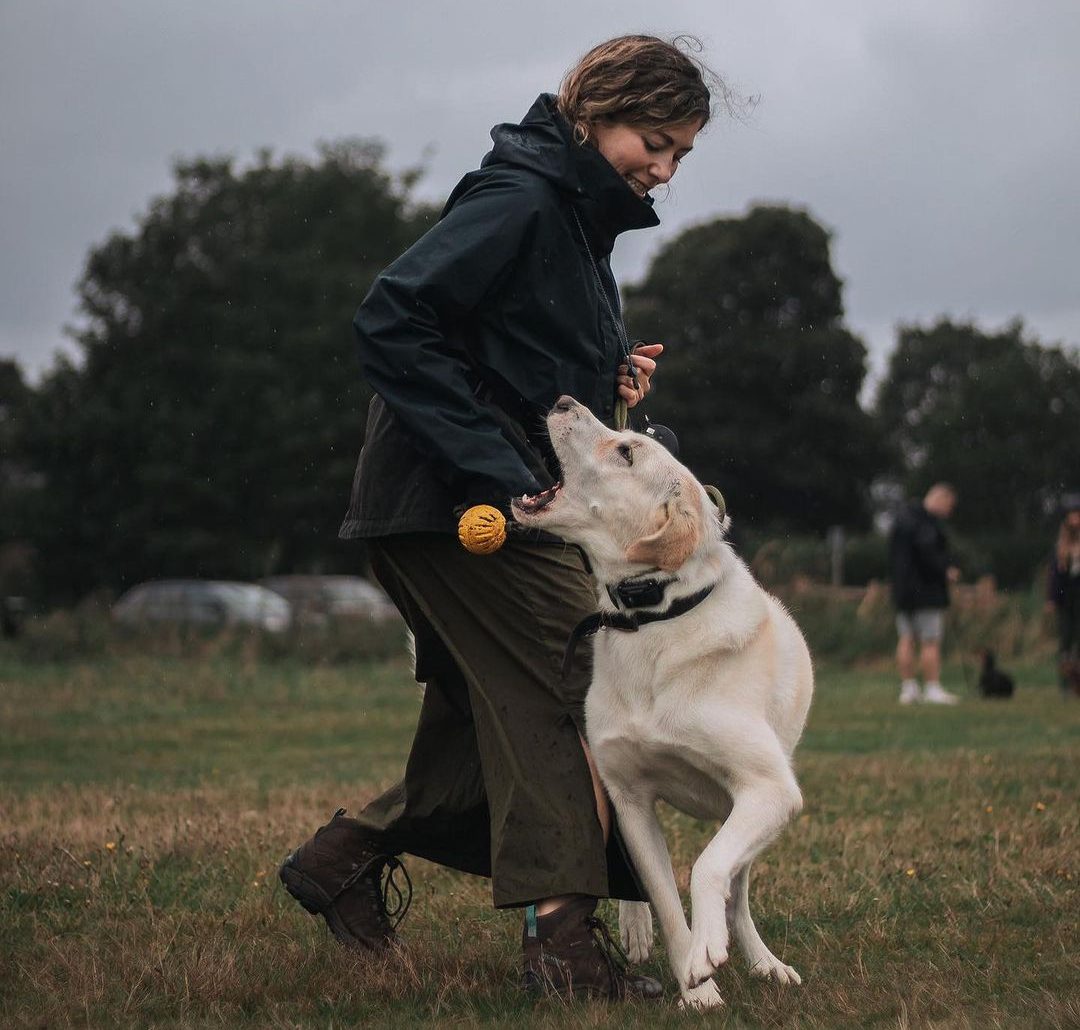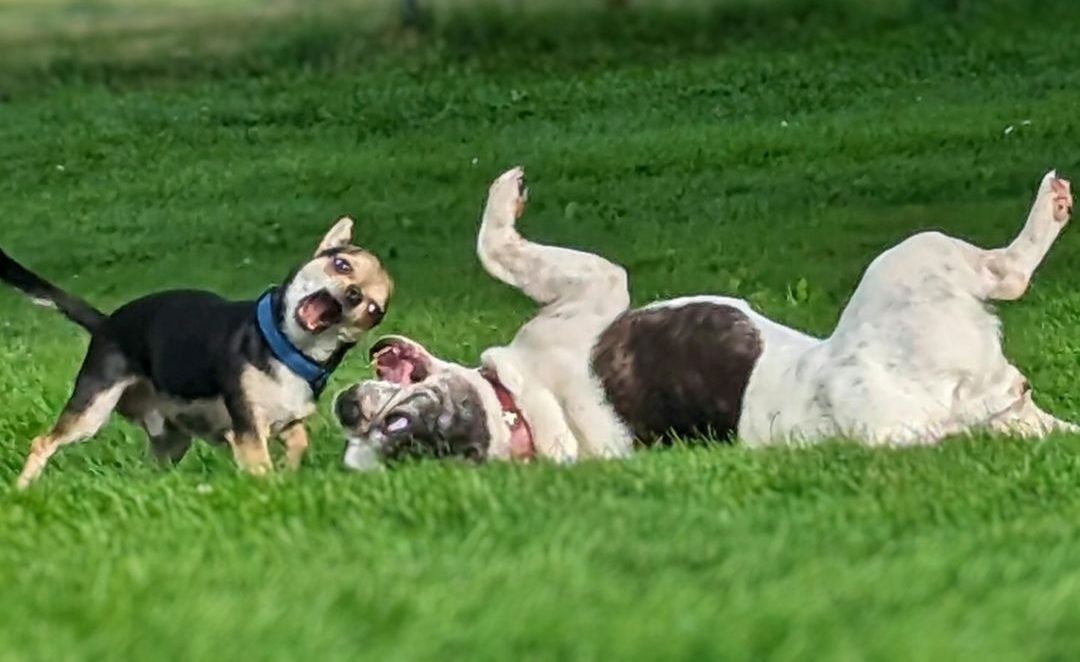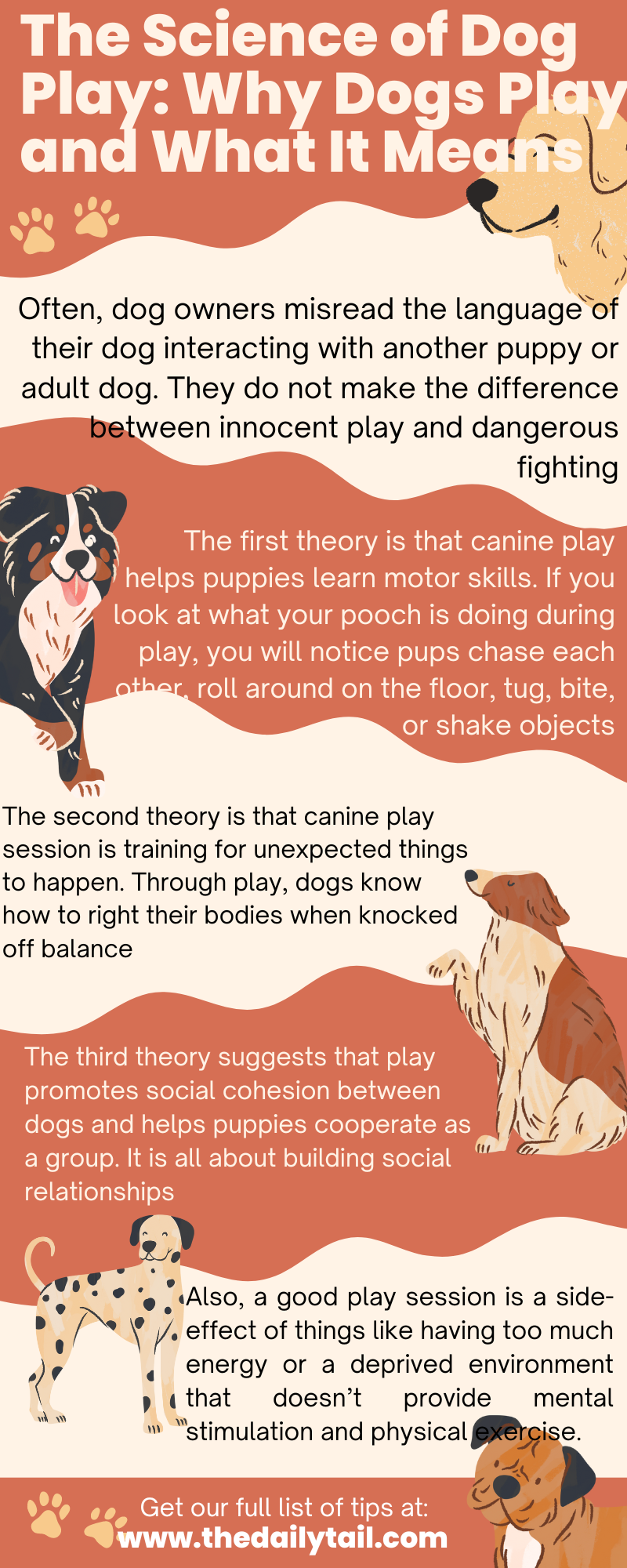Often, dog owners misread the language of their dog interacting with another puppy or adult dog. They do not make the difference between innocent play and dangerous fighting. Sometimes, owners might take too lightly what is actually an aggressive behavior. What is important is to learn the communication of dogs. Understand what is dog play, why dogs play, and what is the message behind it.
Dog play is a series of active and repetitive behaviors that have different meanings. More importantly, this type of communication helps canines develop important life skills and experiences.
Playing relies on the ability to read vocal and body signals. Dogs do not have that opportunity and are usually deficient when it comes to communicating and identifying signals.
We have to remember that play is a mock battle, and dogs sometimes tend to play rudely. You can notice signals like body slamming, mouthing too hard, mouthing, and generally causing mayhem.
History of Dog Play
As we all know, dogs are descendants of wolves. Some 80,000 years ago, or even more, wolves began hanging around the camps of early humans. At that point, humans have already learned to control fire and cook food.
Wolves feared fire as feral animals, but humans would throw their waste, including bones and gristle out into the darkness. Wolves would get a free meal and were brave enough to approach the camp.
Over time, a relationship between wolves and humans developed. So, packs of wolves took it upon themselves to guard the perimeter of the camp from other predators and continue to get free food.
At some point, wolf puppies entered the camps and became members of the human tribe. And wolves were juvenile in nature. In some way, modern dogs are wolf puppies that never reach maturity, staying puppies their whole lives. And they always like to play, even when they are older.
So, dog play has been part of canine lives for long before we had specific breeds.
Quick Facts about Dog Play
Before we talk about why dogs play, let’s take a look at some quick facts about this play behavior.
- Most young puppies learn to play from their peers or elders. Yet, some, due to lack of socialization, are simply hardwired to be rude and do not back down
- If a dog is pushy or plays too rough, it should not interact with other dogs until he or she learns to greet and play nicely
- You should always teach a reliable recall before you allow your dog to roam freely and play with other dogs
- Appropriate play can look very rough, and even resemble aggressive behavior. But in rare cases, you should intervene
- As long as each dog allows the other to win and lose the game, conflict can be avoided. Yet, the more aroused dogs become, they are more likely to turn a mock battle into a serious aggression
- Dogs that know how to play are usually confident and actively seek other dogs to play with. They maintain order by using clear signals so that other dogs do not become too aroused or overwhelmed
- Play often begins in puppyhood, often in the litter, and puppies develop coordination while practicing social skills
Four Reasons Why Do Dogs Play
So far, there is no clear answer to why dogs play. There are, however, several theories that try to give an answer to this dog behavior.
The first theory is that canine play helps puppies learn motor skills. If you look at what your pooch is doing during play, you will notice pups chase each other, roll around on the floor, mount, pick up objects, tug, bite, or shake objects. Puppies can also learn how hard they can bite their playmates. Simply put, puppies are learning real skills relevant to their life.
The second theory is that canine play session is training for unexpected things to happen. Through play, dogs know how to right their bodies when knocked off balance. They learn how to cope when something surprising startles them. According to this particular theory, there are changes in the brain and in hormone levels that help dogs learn how to cope with real-life stressful situations.
Now, onto the third theory. This suggests that play promotes social cohesion between dogs and helps puppies cooperate as a group. It is all about building social relationships. The theory suggests that humans can also take part. But remember, dogs prefer to play with people they know. They are more likely to approach the winner of a game.
The last theory suggests that a good play session is a side-effect of things like having too much energy or a deprived environment that doesn’t provide mental stimulation and physical exercise.
How Playtime Impacts Behavior And Health
We mentioned earlier that play is an important part of socialization and communication. According to many behavior experts, social play with other dogs is good for canine welfare. Now, there are always risks that it might turn into aggressive behavior and cause injuries. But when two well-mannered dogs play together, it is all about a positive impact on their health.
Play can also be part of positive reinforcement dog training. Any dog owner can use play to promote certain behaviors. For example, when my dog Milo is calm and well-mannered outside, I initiate a game with a ball or something. You can also use a squeaky toy or a tug toy.
When we are outside, if he is too aroused, he doesn’t get to play with other dogs. I allow him to play when he is well-mannered.
Play is one of the best rewards you can give to a dog. So use it in your training.
Why Do Dogs Play With Other Dogs?
Simply put, when dogs play with other dogs, their brain releases oxytocin, the happiness hormone. It is all about socialization here. We have to remember, dogs learn to play with other dogs from a young age.
Take a look at any dog litter. You will see puppies playing with each other before they even open their eyes.
Do Dogs Play With Humans?
When there are people around, dogs prefer to play with their human. They rarely play on their own if there are people around. Milo might play with his toy for a quick second. But then he instantly brings the toy to me, inviting me to play.
Playing with other dogs fulfils a different stimulation for dogs than playing with humans. When they play with dogs, they socialize. Playing with dogs releases oxytocin and cortisol in dogs, reducing their stress and increasing happiness.
When dogs play with humans, it is all about the bond they share. Most dogs prefer to engage with a familiar person over an unfamiliar one. Unless, of course, you have a Golden Retriever. He will play with anybody.
So, Why Do Dogs Play?
Ultimately, dog play is something that helps puppies learn motor skills, build social cohesion, and prepare themselves for unexpected things.
Now, while play is an excellent thing to do and an important part of socialization, I do not recommend doing it in the dog park. Why? Because the dog park is a place where you cannot control who enters and what type of dog they bring.
One of the worst things you can do is to bring a dog with zoomies to the park to “burn its energy”. It is a recipe for disaster. And I strongly suggest you avoid the park where there are too many dogs for a dog play session.
Better find some people with dogs you know and like, and schedule a “dog date”. How to know whether dogs want to play? Well, pay attention to the play-bow. It is a play behavior that invites other dogs. And no, it doesn’t matter whether you have a small dog or a large dog. Dogs of all sizes can play together. Milo had a Cane Corso best friend.










